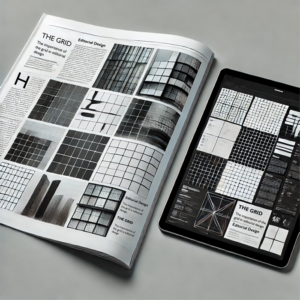
The Grid in Editorial Design: A Legacy of Structure and Creativity
Editorial design is built on the foundation of structure and order, and one of its most essential tools is the grid. From the earliest printed manuscripts to contemporary digital interfaces, the grid has played a crucial role in organizing content, ensuring consistency, and guiding the reader’s experience. While the grid was once a rigid framework, modern designers have found ways to push its boundaries, using it as both a guide and a tool for creative expression.
The History of the Grid in Editorial Design
The concept of the grid can be traced back to the earliest forms of written communication. Ancient manuscripts and handwritten texts, such as illuminated medieval manuscripts, relied on carefully measured margins and column structures to ensure readability. However, the systematic use of grids in editorial design truly took form with the invention of the printing press in the 15th century.
During the Renaissance, typographers and printers, including Johannes Gutenberg, refined the use of consistent column layouts to organize information efficiently. This principle carried through to newspapers and books, where justified text, balanced columns, and symmetrical layouts became standard. The industrialization of print media in the 19th and 20th centuries further emphasized the importance of the grid, as it allowed mass production to maintain uniformity across multiple publications.
The modernist design movement of the 20th century, particularly through the work of Swiss designers like Josef Müller-Brockmann, cemented the grid’s role in editorial design. The Swiss Grid System emphasized clarity, order, and mathematical precision, leading to structured yet visually compelling layouts. This movement influenced not only print but also the emerging field of corporate and advertising design.
The Role of the Grid in Print Media
For printed materials such as newspapers, magazines, and books, the grid serves as an invisible framework that dictates how content is arranged on a page. Some key functions of the grid in print editorial design include:
- Establishing Visual Hierarchy: By dividing content into sections, grids help prioritize information. Headlines, subheadings, body text, and images are positioned according to their importance, guiding the reader’s eye naturally across the page.
- Ensuring Consistency: Publications that maintain a consistent grid structure create a sense of coherence. Whether a reader flips through a magazine or follows an article across multiple pages, the familiarity of the grid enhances readability and engagement.
- Balancing Content and White Space: A well-structured grid allows for the harmonious arrangement of text and images while preventing overcrowding. This balance improves both the aesthetic appeal and legibility of printed materials.
The Evolution of Grids in Digital Editorial Design
With the rise of digital publishing, web design, and mobile applications, grids have adapted to new formats and technologies. Unlike the fixed nature of print, digital design requires flexibility due to varying screen sizes and resolutions. Some notable evolutions in grid usage for digital editorial design include:
- Responsive Grid Systems: Digital layouts must accommodate different devices, from desktops to smartphones. Flexible grid systems, such as those based on CSS frameworks (e.g., Bootstrap, CSS Grid), allow content to dynamically adjust while maintaining structural integrity.
- Modular and Asymmetrical Grids: While traditional print design often relied on symmetrical grids, digital design has embraced modular grids and broken layouts. These designs offer a contemporary, dynamic feel while still adhering to fundamental structural principles.
- Creative Grid Manipulation: In modern editorial design, designers often break conventional grids intentionally, creating unexpected alignments and overlaps that add visual interest while maintaining readability.
Grids as a Tool for Creative Expression
Despite their structural nature, grids are not meant to be restrictive. Contemporary designers use them as a foundation rather than a limitation. Some ways in which designers creatively manipulate grids include:
- Overlapping Elements: Text and images that extend beyond conventional grid boundaries create depth and energy.
- Irregular Spacing: Instead of rigid symmetry, designers introduce varied column widths or spacing for a more engaging layout.
- Layering and Transparency: Using grids to strategically layer content elements allows for a visually rich reading experience.
The Enduring Relevance of Grids
Whether in traditional print media or digital editorial design, the grid remains an indispensable tool for structuring content. It provides the necessary foundation for readability, consistency, and balance while allowing designers to explore innovative and expressive layouts. As design continues to evolve, the grid will remain a guiding force—both as a method of order and as a playground for creative possibilities.